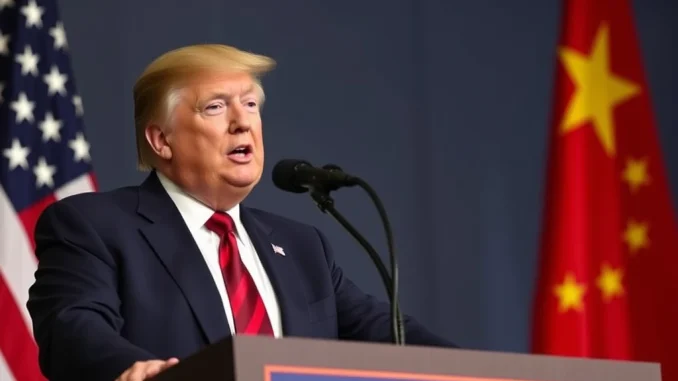
In a surprising turn of events, former U.S. President Donald Trump has publicly stated his eagerness to resume business dealings with China. This announcement comes amidst ongoing global economic uncertainties and has sparked discussions across various sectors, including the cryptocurrency market. Could this be a sign of easing tensions and a potential boost for the global economy? Let’s delve into the details of this developing story and explore what it might mean for you.
Trump China Trade: A Shift in Stance?
During a recent Cabinet meeting, Trump articulated his desire to engage in commerce with China, expressing optimism for a mutually beneficial outcome. This statement marks a notable point, especially considering the complex history of trade relations between the two economic giants. Here’s a breakdown of what we know:
- Trump’s Statement: He explicitly mentioned wanting to “do business with China,” indicating a potential softening of his previously hawkish stance on trade.
- Optimism for Outcome: Trump believes a “good outcome” is achievable for both the United States and China, suggesting a move towards negotiation and resolution rather than continued conflict.
- Tariff Postponement: Just yesterday, Trump announced a 90-day postponement on reciprocal tariffs for countries other than China. This action could be interpreted as a strategic move to isolate China or, conversely, to create a more conducive environment for bilateral trade discussions.
- Tariff Increase on China?: Adding a layer of complexity, the White House also indicated an increase in total tariffs on China to 145%, up from a previously reported 125%. This seemingly contradictory information raises questions about the administration’s precise strategy.
It’s important to note that these announcements are unfolding rapidly, and the situation remains fluid. The interplay between the desire for a Trump China trade deal and the simultaneous increase in tariffs creates a somewhat ambiguous picture. Understanding the nuances is crucial for anyone watching the global economic landscape, particularly those invested in or interested in cryptocurrency.
US China Trade Relations: A Rocky Road So Far
The relationship between the U.S. and China on trade has been anything but smooth in recent years. Characterized by periods of intense negotiation, escalating tariffs, and fluctuating sentiments, the US China trade dynamic has significantly impacted global markets. Let’s recap some key milestones:
| Event | Description | Impact |
|---|---|---|
| 2018: Initial Tariffs | The U.S. began imposing tariffs on billions of dollars worth of Chinese goods, citing unfair trade practices. | Escalated tensions, triggered retaliatory tariffs from China, and created uncertainty in global supply chains. |
| 2019: Trade War Escalation | Both countries increased tariffs on each other’s goods multiple times, leading to a full-blown trade war. | Slowed down global trade, impacted businesses across sectors, and caused market volatility. |
| 2020: Phase One Deal | A partial trade agreement was signed, offering some relief and promising increased Chinese purchases of U.S. goods. | Provided temporary stability, but many fundamental trade issues remained unresolved. |
| 2021-Present: Continued Tensions | Despite the Phase One deal, trade tensions have persisted, with ongoing concerns about intellectual property, market access, and geopolitical competition. | Maintained a level of uncertainty in trade relations, with businesses adapting to a new normal of potential disruptions. |
Against this backdrop, Trump’s recent comments inject a new element of potential change. Whether this signals a genuine shift in strategy or is a tactical maneuver remains to be seen. For investors, businesses, and anyone following global economics, closely monitoring the developments in US China trade is paramount.
Decoding the Trade Deal Ambiguity: What Does Trump Really Mean?
Trump’s statement about wanting a trade deal with China, while seemingly straightforward, needs careful interpretation. Political and economic motivations often intertwine, and understanding the potential underlying factors can provide valuable insights.
- Economic Considerations: The U.S. economy, like many others globally, faces various challenges. Easing trade tensions and securing a favorable trade deal could be seen as a way to stimulate economic growth and reduce inflationary pressures.
- Political Strategy: Trump’s pronouncements often have a strong political dimension. Expressing a desire for a deal could be aimed at appealing to certain voter segments, projecting an image of strength and deal-making prowess, or even setting the stage for future negotiations.
- Negotiating Tactics: The simultaneous announcement of increased tariffs alongside the desire for a deal could be a classic negotiating tactic. By signaling both willingness to engage and continued pressure, the administration might be aiming to extract more favorable terms from China.
- Global Geopolitics: The US-China relationship extends beyond trade to encompass a wide range of geopolitical issues. Trade discussions could be linked to broader strategic considerations, such as regional influence, technological competition, and international alliances.
Therefore, when we hear about a potential trade deal, it’s essential to look beyond the surface. Analyzing the context, considering various motivations, and staying informed about related policy announcements will be key to understanding the true direction of US-China trade relations.
China Tariffs: The Double-Edged Sword
Tariffs, particularly China tariffs, have been a central tool in the US trade policy arsenal. While intended to protect domestic industries and address trade imbalances, they also carry potential risks and complexities. Let’s examine the dual nature of tariffs:
Potential Benefits of Tariffs:
- Protecting Domestic Industries: Tariffs can make imported goods more expensive, thereby giving domestic producers a competitive advantage.
- Addressing Unfair Trade Practices: They can be used as leverage to pressure countries to change practices deemed unfair, such as intellectual property theft or forced technology transfer.
- Generating Revenue: Tariffs are a form of tax on imports, which can generate revenue for the government.
Potential Challenges of Tariffs:
- Increased Consumer Costs: Tariffs can lead to higher prices for imported goods, which can be passed on to consumers.
- Retaliation: Imposing tariffs often invites retaliatory tariffs from the targeted country, harming export industries.
- Supply Chain Disruptions: Tariffs can disrupt global supply chains, making it more expensive and complex for businesses to operate.
- Economic Slowdown: Widespread tariffs can contribute to trade wars, which can negatively impact economic growth both domestically and globally.
The announced increase in China tariffs to 145% (if confirmed and implemented) would represent a significant escalation. Such a move could have substantial repercussions, potentially offsetting any positive sentiment generated by Trump’s desire for a trade deal. The actual impact will depend on a multitude of factors, including the specific goods targeted, the duration of the tariffs, and China’s response.
Global Economy Impact: Ripples Across Markets
The developments in US-China trade relations have far-reaching implications for the global economy. These two nations are the world’s largest economies, and their trade policies exert considerable influence worldwide. Here’s how shifts in their trade dynamic can create ripples across markets:
- Market Volatility: Trade tensions and uncertainty often lead to increased volatility in financial markets, including stock markets, currency exchange rates, and commodity prices.
- Supply Chain Reconfigurations: Businesses may need to adjust their supply chains to mitigate the impact of tariffs and trade disruptions, leading to shifts in production locations and trade routes.
- Impact on Emerging Markets: Emerging economies can be particularly vulnerable to trade wars, as they rely heavily on international trade and investment.
- Inflationary Pressures: Tariffs can contribute to inflationary pressures by increasing the cost of imported goods and intermediate inputs for production.
- Geopolitical Stability: Economic relations are intertwined with geopolitical stability. Improved trade relations can foster cooperation, while escalating trade tensions can exacerbate geopolitical risks.
For the cryptocurrency market, which is increasingly integrated with the global financial system, these macroeconomic factors are relevant. While not directly correlated in a simple linear fashion, events impacting the global economy can indirectly influence investor sentiment, risk appetite, and capital flows, all of which can affect cryptocurrency valuations.
What’s Next? Navigating the Uncertainties
The situation surrounding US-China trade remains dynamic and uncertain. Trump’s recent statements add a new layer of complexity. To navigate these uncertainties effectively, here are some key points to consider:
- Monitor Policy Announcements: Stay informed about official statements and policy announcements from both the U.S. and Chinese governments regarding trade.
- Analyze Economic Data: Pay attention to economic indicators that reflect the impact of trade policies, such as trade balances, inflation rates, and GDP growth.
- Assess Market Reactions: Observe how financial markets react to trade-related news, as market sentiment can provide valuable clues.
- Consider Expert Opinions: Seek insights from economists, trade analysts, and geopolitical experts to gain a deeper understanding of the situation.
- Prepare for Volatility: Be prepared for potential market volatility as trade negotiations and policy adjustments unfold.
Conclusion: A Glimmer of Hope or a Tactical Maneuver?
Donald Trump’s expressed desire to “do business with China” offers a potential glimmer of hope for easing trade tensions and fostering a more stable global economic environment. However, the simultaneous indication of increased tariffs adds a layer of ambiguity. Whether this marks a genuine shift towards reconciliation or is a tactical maneuver in a complex negotiation remains to be seen.
For those watching the cryptocurrency markets and the broader global economy, staying informed and prepared for potential fluctuations is crucial. The interplay between US-China trade relations and global economic health will continue to be a significant factor shaping market dynamics in the days and weeks to come. Keep a close eye on further developments, as they could signal important shifts in the global economic landscape and potentially create new opportunities and challenges across various sectors, including the exciting and ever-evolving world of cryptocurrency.



